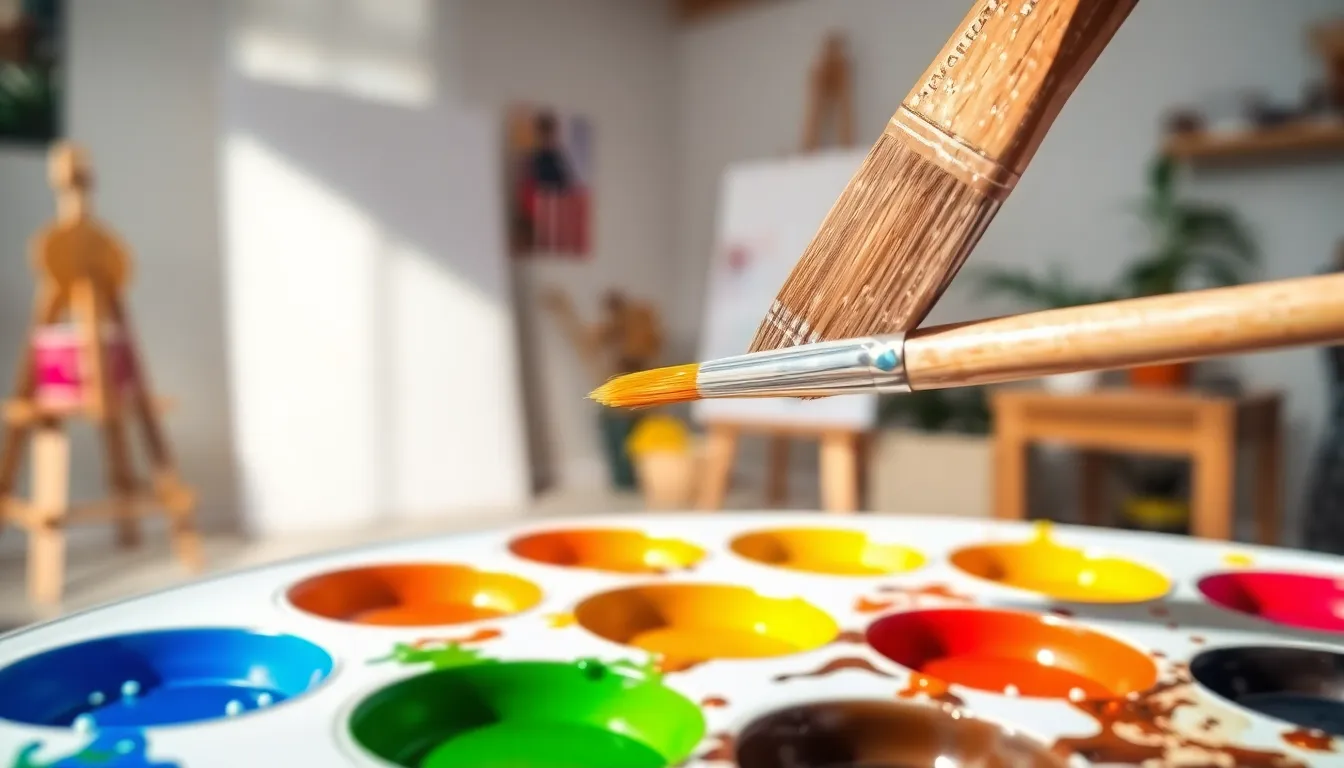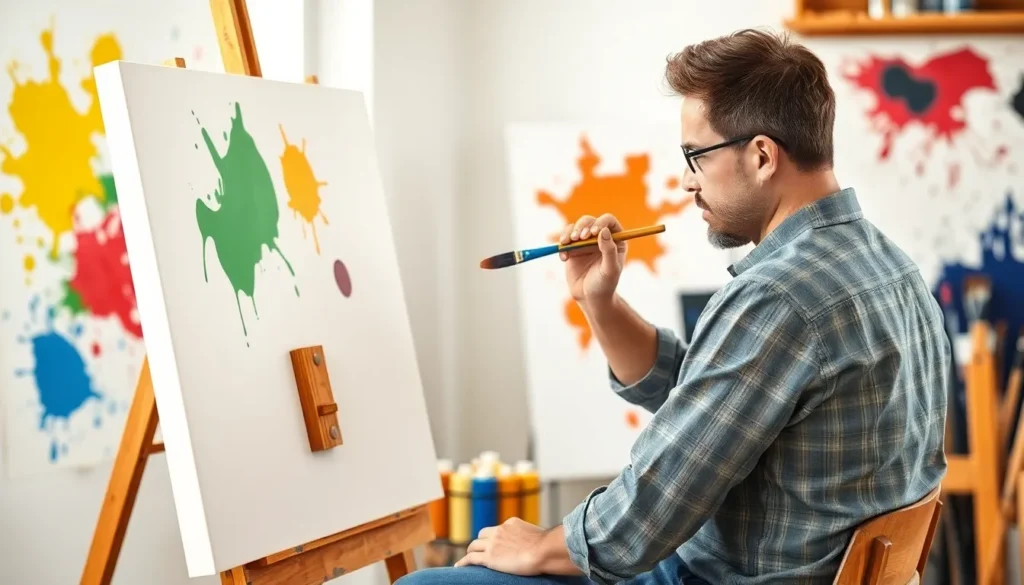Picture this: you’ve just finished a masterpiece, but instead of smooth, flawless strokes, your canvas looks like it’s been through a bumpy road trip. Brush strokes can turn a beautiful painting into a hot mess faster than you can say “artistic disaster.” Thankfully, there’s hope!
Table of Contents
ToggleUnderstanding Brush Strokes
Brush strokes can significantly influence the final appearance of a painting. Understanding their causes and effects helps improve techniques and achieve a polished result.
What Causes Brush Strokes?
Several factors contribute to visible brush strokes. Using the incorrect brush type leads to uneven application. Dried paint on the brush can create unwanted texture. Additionally, selecting a thicker paint consistency often causes marks that are harder to smooth. Poor application techniques, like pressing too hard, result in heavy strokes. Environmental conditions also play a role; for instance, painting in low humidity can cause paint to dry too quickly, leading to more noticeable strokes.
Importance of Smooth Finishes
Smooth finishes elevate the overall quality of a painting. Achieving even surfaces enhances visual appeal and creates a professional look. When the paint glides effortlessly, it allows the colors to blend seamlessly. Such finishes can express artistic intentions more clearly. Art critics and viewers often notice smoothness, which contributes to the painting’s reception. Artists aiming for realism or abstraction benefit from diminishing brush stroke visibility.
Choosing the Right Paint

Choosing the right paint significantly reduces brush strokes and improves overall finish. Various paint types and qualities play a critical role in achieving desired results.
Types of Paint for Smooth Application
Acrylic paint offers quick drying times, making it ideal for those seeking smooth application. Oil paint, known for its rich texture, provides extended blending time but requires patience. Watercolor paint enables fluid techniques, producing delicate transitions with minimal brush stroke visibility. Latex paint works well for large surfaces, promoting a smoother finish when applied properly. Selecting any of these options depends on the project’s specific requirements and desired effects.
Advantages of High-Quality Paints
High-quality paints deliver better coverage, meaning fewer layers are needed to achieve a solid color. These paints maintain uniformity in texture, minimizing the appearance of brush strokes. Enhanced adhesion properties reduce chances of peeling, ensuring durability in the long run. Additionally, premium paints often feature improved pigment concentration, resulting in vibrant colors that stand the test of time. Investing in high-quality paint translates into improved artistic outcomes and professional finishes.
Selecting the Appropriate Brushes
Choosing the right brushes improves painting techniques and minimizes brush strokes. Brush selection directly influences the overall finish of artwork.
Different Brush Types and Their Uses
Selecting the correct brush type is essential for achieving desired effects. Flat brushes deliver broad strokes, perfect for covering large areas. Rounded brushes suit detailed work and fine lines. Filbert brushes combine the qualities of flat and round, allowing for versatile applications. Fan brushes create texture, ideal for foliage or hair effects. Angled brushes help in precise edges, especially for corners and intricate details. Understanding these brush types helps artists enhance their work while drastically reducing visible brush strokes.
Recommended Brush Materials
Brush materials impact application quality and finish. Synthetic brushes offer durability and versatility, suitable for various paint types. Natural bristles provide a softer touch, allowing for smooth paint application. For acrylic paints, synthetic brushes often perform best due to their resilience. Natural hair brushes enhance oil paint application, as they hold more paint and water. Each material contributes to achieving a professional finish, enabling artists to minimize brush strokes effectively. Prioritizing appropriate materials ensures optimal results in every painting endeavor.
Mastering Painting Techniques
Mastering the right painting techniques enhances the final appearance of any artwork. Proper brushwork reduces the visibility of brush strokes, allowing for a smoother finish.
Proper Brush Loading
Loading the brush correctly leads to an even application. Dip the brush into the paint, ensuring it’s at least one-third coated. Avoid overloading, as excess paint can lead to awkward brush strokes. Instead, aim for a balanced amount that allows gentle application. Tapping the brush against the edge of the paint container removes extra paint, which helps achieve control. Adjusting the brush angle while painting further aids in controlling paint distribution. Using the right amount allows the artist to maneuver the brush easily across the surface.
Techniques for Even Application
Focusing on even application techniques leads to smoother finishes. Start with light pressure; this ensures paint spreads evenly without clumping. Implement broad strokes for larger areas; using flat brushes promotes an even coat of paint. For detail work, switch to smaller brushes, applying small, controlled strokes. Blending colors on the canvas while the paint is wet introduces a seamless look. Utilizing a swirling motion instead of linear strokes can help in creating a cohesive texture. Practicing these techniques leads to a more professional outcome and enhances artistic expression.
Finishing Touches
Finishing touches play a vital role in perfecting a painting. They help ensure a smooth, professional finish that enhances the artwork’s appeal.
Using Rollers for a Smoother Finish
Rollers can provide an even application, significantly reducing visible brush strokes. Flat surfaces benefit from roller use, creating a consistent layer of paint. Artists often choose foam rollers for delicate finishes, as they spread paint without texture. Selecting the appropriate size roller can also improve coverage on larger areas. Experimenting with various roller types leads to different finishes, so it’s helpful to test each before committing to a project.
Techniques for Touch-Ups
Touch-ups require precision for maintaining a seamless look. Using a fine brush for detailed areas ensures that imperfections blend into the surrounding paint. Applying a thin layer of paint during touch-ups allows for controlled adjustments. Smartly matching the existing paint color reduces noticeable differences, and blending at the edges can further conceal imperfections. Artists sometimes use a stippling technique to soften rough spots, making corrections less visible.
Achieving a smooth finish without visible brush strokes is within every artist’s reach. By selecting the right materials and mastering essential techniques, they can elevate their artwork to new heights. Attention to detail during the painting process plays a pivotal role in minimizing imperfections. Whether using high-quality paints or suitable brushes, each choice contributes to a more polished result.
Incorporating finishing touches and employing effective application methods can further enhance the overall appearance. With practice and perseverance, artists can create stunning pieces that reflect their true vision. Embracing these strategies not only improves the quality of their work but also boosts confidence in their artistic abilities.




